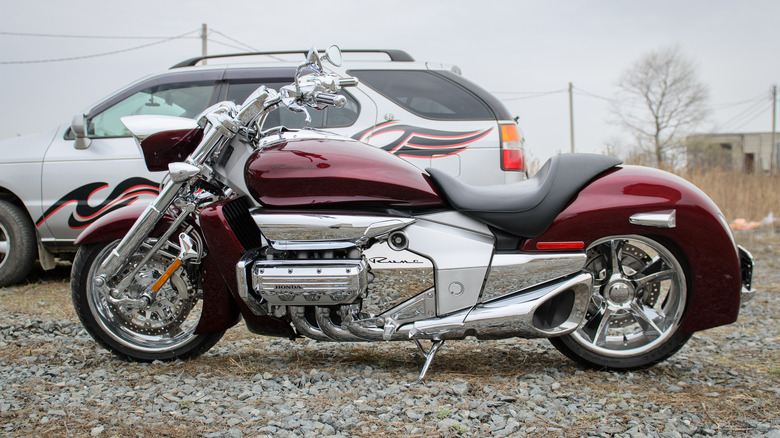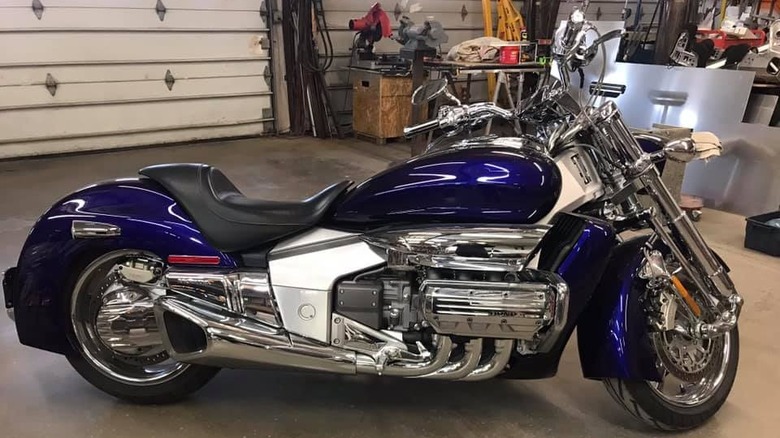This Masterpiece Motorcycle Was One Of Honda's Most Expensive Creations
According to Merriam-Webster's dictionary, a "rune" is a symbol or character used in the writings of many Germanic peoples of the ancient past. It can also be a Finnish or Old Norse poem. Spelled differently, but pronounced similarly, is "ruin" — which means to damage irreparably, devastate, impoverish, go bankrupt ... well, you get the drift. In the case of Honda, the "Rune" may have leaned the other way.
Believe it or not, Honda's Rune was an even larger version of its already behemoth-sized Valkyrie. This drop-dead gorgeous masterpiece of motorcycle engineering dripped with decadence, and was so absurdly over the top that it almost ruined the company. Okay, maybe not the company, but with an MSRP of $27,000 (via National Motorcycle Museum), it likely ruined many consumers' bank accounts when released in 2004.
No performance goals with no distinct function, and the purchase price was not a consideration. According to FortNine, these were actual directives from Honda project leader Masanori Aoki, of Gold Wing GL1800 fame. The only real goal was to make it look nice while being road legal. Thus, it began with a styling model, not Honda's usual engineering design (via Honda).
It was borne from the Zodia concept, first shown at the 1995 Tokyo Motor Show (via TopSpeed). Over the next few years, it underwent several revisions (T1 through T4), which were displayed at shows from 1998 through 2000 (via TopSpeed).
Getting ruined never looked so good
But the Rune wasn't just a one-off Valkyrie or a tweaked Gold Wing. Nor was anything on this bike grabbed willy-nilly off the ready-made parts shelf. Not even the buttons. For instance, the headlight, tank, and radiator (among other things) were all constructed with a teardrop shape, so everything matched.
At what cost, you might ask? Well, according to FortNine, the specially built radiator grill had a list price of $1,572. Something as simple as the master cylinder had a price tag of $1,350, while each engine guard cost $1,010.
The uniquely Rune exhaust tips were made using a 5,000-year-old wax method that someone stumbled on in an archive somewhere (explained in the above video at the six-minute mark). But the process is interesting and incredibly expensive, with each tip costing, in theory, $1,300 to replace. Unfortunately, you can't replace them because Honda didn't make more than the allotted amount sold (via FortNine).
To keep the 7-foot long, nearly 900-pound bike so incredibly stable and exquisitely drivable, the axel on the front fork (with a list price of $18,000, mind you) was designed to trail nine inches behind the pivot point. The gas tank is 32 inches long, while the foot-long teardrop-shaped headlight costs $2,672 to replace (via FortNine).
These Runes are few and far between
Another unique feature worth mentioning that further proves how much engineering went into the bike is the linked brakes. According to FortNine, stepping on the rear brake activates a piston that automatically slows down the cycle as it goes through a sharp turn, belying the big bike's nimbleness. That command, in turn, is sent through an additional delay valve so the rider won't experience any steering issues.
So what about the beastly-looking engine? Honda took the flat-six 1832cc from the Gold Wing and tweaked it. Instead of the standard two cylinders, the Rune had six (via Motorious). Additionally, it was liquid-cooled and produced 118 horsepower at 5500 rpm, with 123 lb-ft of torque at 4000 rpm (via Autoevolution).
While the exact number of units sold has never been confirmed, FortNine claims that VIN records show only 1,485 bikes were made. Other estimates peg it at only "a few thousand" (via National Motorcycle Museum), so ... not many. It's thought that Honda's out-of-pocket cost for each bike was anywhere from $100,000 (via TopSpeed) to $150,000 (via FortNine), depending on how many were actually built.
With the bike's MSRP amounting to a quarter of that, simple math says it lost nearly $75,000 per bike, losing the company some $225 million (via TopSpeed). All because they went with form over function. To rune, or not to ruin?

